The Book of Armaments:
Edgar Brandt’s Creations
by Mike Bennighof, Ph.D.
March 2021
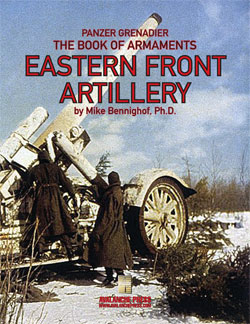 Designer and iron-worker extraordinaire Edgar Brandt made his mark on the world at the 1925 Paris Exhibition of Decorative Arts, a celebration of the style known as Art Deco. Brandt had already won fame in France for crafting the massive wrought-iron gates for the Trench of Bayonets at the Verdun war memorial, and the fallen German eagle at the Compiegne memorial. Designer and iron-worker extraordinaire Edgar Brandt made his mark on the world at the 1925 Paris Exhibition of Decorative Arts, a celebration of the style known as Art Deco. Brandt had already won fame in France for crafting the massive wrought-iron gates for the Trench of Bayonets at the Verdun war memorial, and the fallen German eagle at the Compiegne memorial.
At the Paris exhibition Brandt showed off his decorative gates, fireplace screens and doors, made of iron and steel carefully hammered to take on a silver-like shine. The technique spoke to the high craftsmanship that defined Art Deco, and would become one of the style’s hallmarks. Brandt followed up on his acclaim by establishing Ferro Brandt, the first Art Deco gallery in Paris. His place in history had been assured.
Well, because of that, and because he also designed weapons.
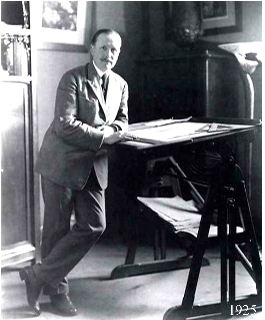 The then-22-year-old Brandt (over there on the right, seen in 1925) established his own iron-working firm in 1902. Though trained as an engineer, he appears to have preferred hefting a hammer and working iron as a blacksmith. When the First World War came, his shop produced a licensed version of the British Stokes trench mortar. The Stokes mortar was a simple steel tube with a firing pin at the base; when the mortar bomb was dropped down the tube, the primer in its base would ignite and lob the bomb out of the tube and at its target, where an impact fuse would set it off. Small metal-working shops like Brandt’s could not make artillery pieces, but the mortar’s construction was well within their capabilities. The then-22-year-old Brandt (over there on the right, seen in 1925) established his own iron-working firm in 1902. Though trained as an engineer, he appears to have preferred hefting a hammer and working iron as a blacksmith. When the First World War came, his shop produced a licensed version of the British Stokes trench mortar. The Stokes mortar was a simple steel tube with a firing pin at the base; when the mortar bomb was dropped down the tube, the primer in its base would ignite and lob the bomb out of the tube and at its target, where an impact fuse would set it off. Small metal-working shops like Brandt’s could not make artillery pieces, but the mortar’s construction was well within their capabilities.
After the war, Brandt continued to tinker with the mortar. Complaints from his neighbors of constant explosions from his establishment led to him move outside Paris to Vernon in Normandy, where he could blow things up without fear of nimby opposition.
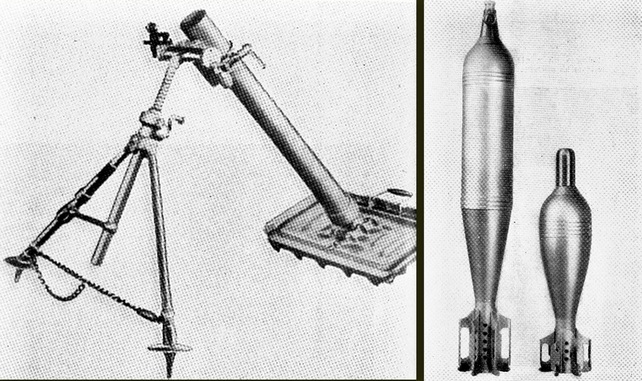
An Argentine-made 81mm Brandt mortar, and its Art Deco ammunition.
While he made some improvements to the tube, bipod and baseplate of the Stokes mortar, his real innovation came in designed Art-Deco-style aerodynamic rounds that would have fit in with the Paris Exhibition. Art Deco made the mundane into art; Brandt’s works included elevator doors and desks among other items. The small works of art he crafted to fire from his mortar (in the style known as Streamlined Modernity) had stabilizing fins that greatly increased both range and accuracy, and were the key feature of his Brandt Model 1927 81mm mortar. A Polish firm copied the weapon a year later, and Brandt won his patent case in court based not on the tube but on the unique features of the ammunition.
The French Army quickly adopted the Brandt mortar as a battalion-level support weapon, and its little brother, the Brandt Model 1935 60mm mortar, as a company-level support weapon (just before the war broke out the French Army ordered a new Model 1937 50mm mortar, called a grenade-thrower, to provide support at the platoon level).
Note: The French Army only issued one 60mm tube per rifle company, and so the weapon does not show up often in Panzer Grenadier scenarios.
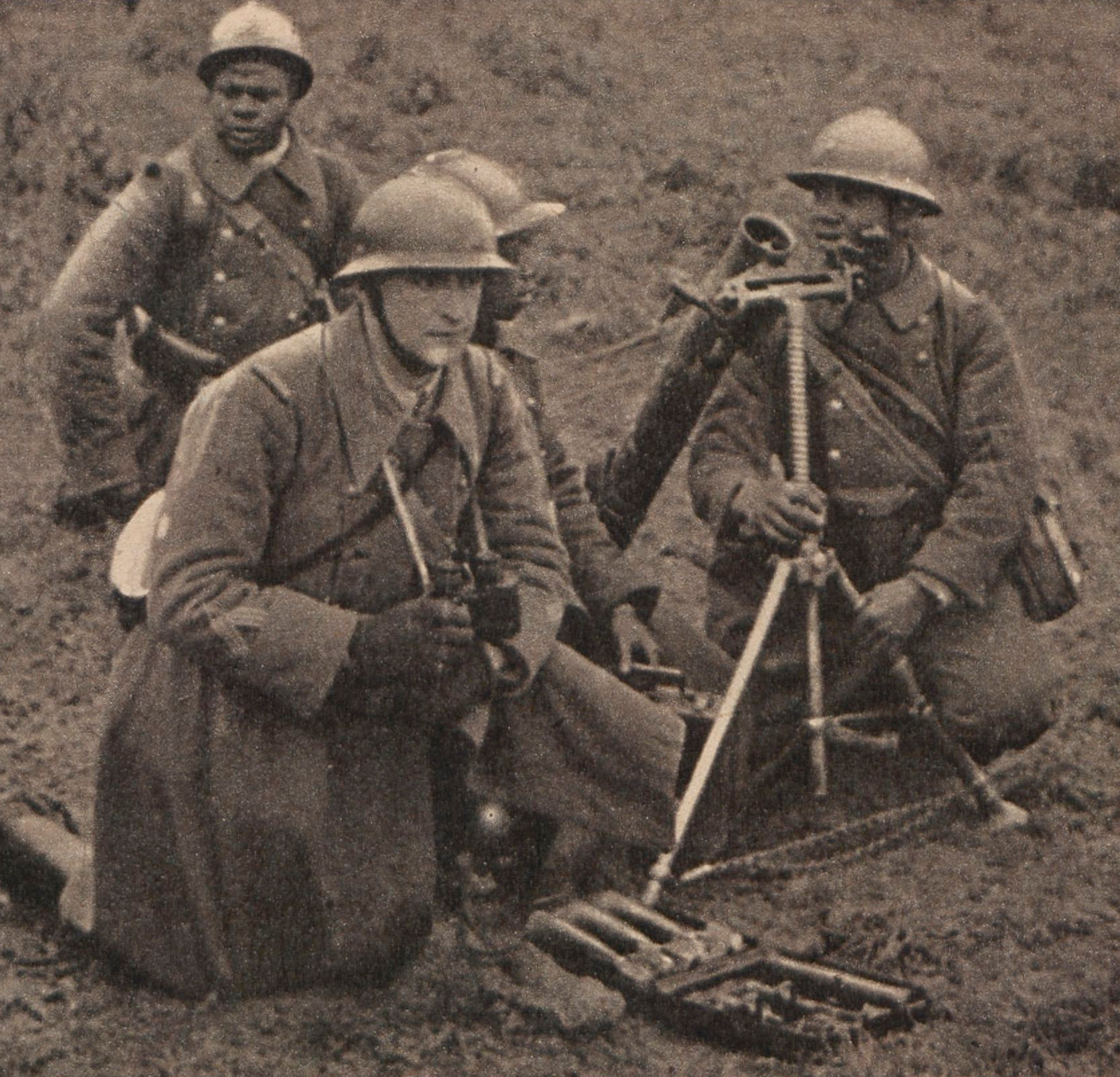
Senegalese Tirailleurs with their 81mm mortar. Note the stylish ammunition case.
The Art Deco rounds could also be fired from the old Stokes mortar, and so the French Army and many others kept these around as well.
The 81mm mortar had a crew of 10 and an enormous rate of fire, pumping out 18 rounds per minute. It could be broken into three loads and along with its ammunition carried by those 10 men and only those 10 men, allowing it to accompany the infantry on foot and give them artillery support within minutes. Of those ten men, a crew of three actually handled firing the mortar.
The original French model tossed a 3.2 kilogram bomb up to 2,000 meters; a heavier round weighed in at six kilograms but could only travel half the range. American projectiles for the licensed M1 mortar gave better performance. Brand had designed the round to have the same impact as the 75mm shells of the quick-firing Model 1897 field gun. Most users added smoke and chemical rounds to their arsenals, and the Americans issued a white phosphorus round as well.
The Brandt mortar quickly became the standard infantry-support weapon of armies around the world, with licensed manufacture in Germany, Poland, Japan, the United States, Britain, Italy, Romania, Denmark, Austria the Netherlands and many other nations. Unlicensed manufacture went on in the Soviet Union and China. Other armies bought copies of the mortar from Ateliers Brandt or one of its many licensees.
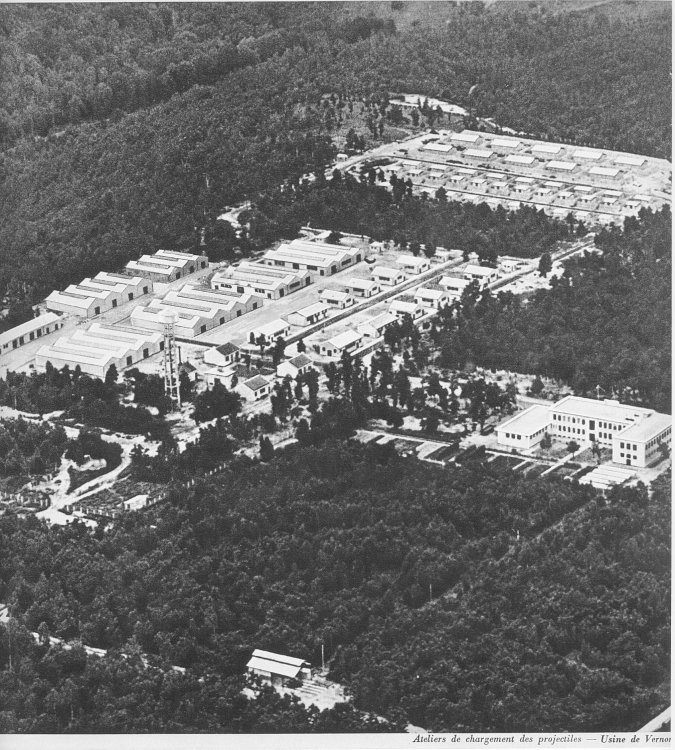
Edgar’s factory, Ateliers Brandt, at the height of its success.
Rheinmetall produced over 75,000 of the German version; the German armed forces and Waffen SS militia also took over thousands more tubes from defeated enemies including the French. The British version, known as the 3-inch mortar (though actually an 81mm, or 3.2-inch, tube like the French original) had somewhat lesser performance that was improved with better ammunition later in the war.
A number of nations produced versions with a shorter tube for jungle, mountain or parachute operations. Austria’s domestic version also had a shorter tube in order to save money; the savings didn’t amount to much, since the weapon was already very cheap to manufacture. And it could be made by countries with a limited industrial base, like Romania or Australia.
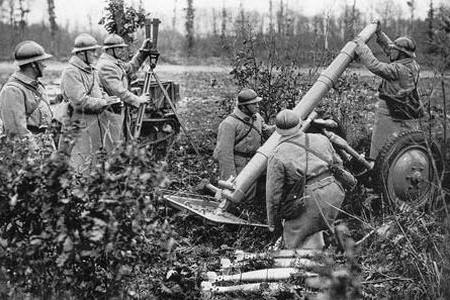
A French crew with a 120mm Modele 1935. A rare photo indeed.
Brandt also produced an enlarged version, the 120mm Modele 1935. It had been accepted by the French Army, with the intention of it becoming a regimental-level support weapon. It had not reached the troops in any appreciable numbers before France fell in June 1940. The Soviets obtained an example, possibly a battlefield capture from the Finns during the Winter War - the Finnish firm Tampella had a production and export license from Brandt - and reverse-engineered it as their M1938 (that wasn’t difficult, as it was just an enlarged 81mm mortar). That weapon was in turn copied by the Germans, Romanians and the United States.
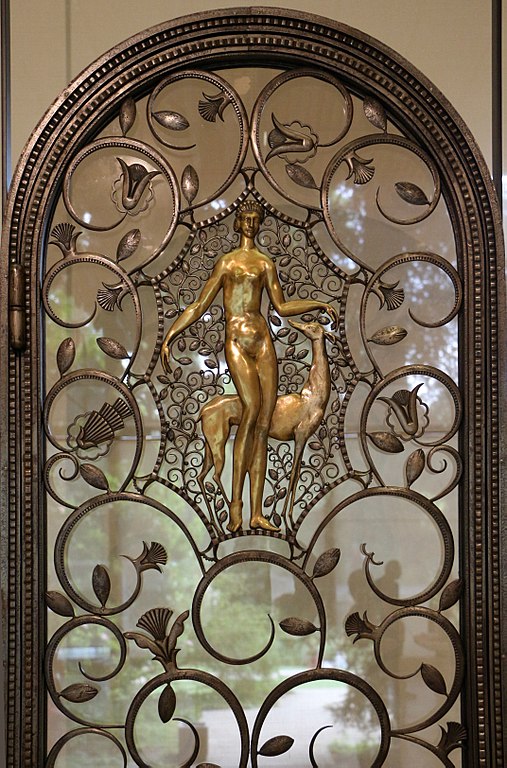 As the orders poured in, France’s Popular Front government nationalized Ateliers Brandt in 1936, buying out Edgar who invested his payment in a series of machinery-producing firms. Brandt himself continued to tinker with weaponry, designing a gun-mortar that could be fired from a level position and equipped several French vehicles. Just before the defeat of France in 1940, he led a team of his engineers that developed armor-piercing discarding sabot (APDS) ammunition (the most important part, the “discarding,” would be perfected by British engineers working alongside Brandt’s team after they evacuated to the United Kingdom). As the orders poured in, France’s Popular Front government nationalized Ateliers Brandt in 1936, buying out Edgar who invested his payment in a series of machinery-producing firms. Brandt himself continued to tinker with weaponry, designing a gun-mortar that could be fired from a level position and equipped several French vehicles. Just before the defeat of France in 1940, he led a team of his engineers that developed armor-piercing discarding sabot (APDS) ammunition (the most important part, the “discarding,” would be perfected by British engineers working alongside Brandt’s team after they evacuated to the United Kingdom).
You can order The Book of Armaments: Eastern Front Artillery right here.
Sign up for our newsletter right here. Your info will never be sold or transferred; we'll just use it to update you on new games and new offers.
Mike Bennighof is president of Avalanche Press and holds a doctorate in history from Emory University. A Fulbright Scholar and NASA Journalist in Space finalist, he has published eleventy-million books, games and articles on historical subjects.
He lives in Birmingham, Alabama with his wife, three children and his dog Leopold. Leopold is streamlined and modern.
Want to keep Daily Content free of third-party ads? You can send us some love (and cash) through this link right here.
|
